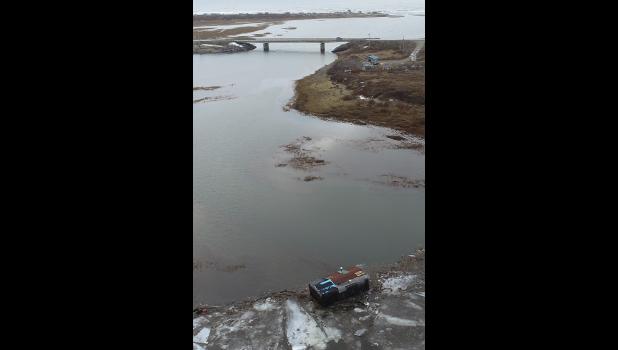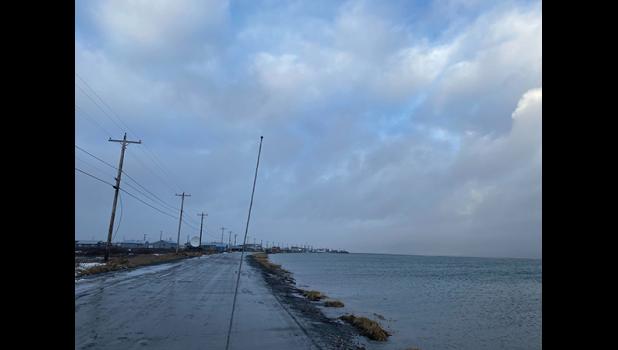Fall storm wreaks havoc
Starting on the night of Wednesday, November 4, and continuing through Friday, a major storm ripped through the Norton Sound region, causing widespread closures and some damaging flooding.
In Teller, the water rose up over the sandspit all the way to the base of the church. Teller Mayor Blanche Garnie said no one was hurt and no homes were damaged, but the entire village prepared to evacuate the main town and seek shelter on the new town site located further uphill. As a whole community, they pitched in to haul boats and skiffs up off the shore and used heavy equipment to clear the icy roads up the hillside.
“Half of our population is in town and we only have 29 tiny, already-crowded privately-owned homes on the hill with no water and sewer,” Garnie said. “Our trash and honey bucket haul crew of two men hauled water to homes in case homes needed water before having extra guests for the flood.”
She said she was especially concerned that the crowding would result in an outbreak of COVID-19. Teller dealt with a number of connected cases during the summer and was able to control the spread, but social distancing was next to impossible as resident crammed into the handful of homes deemed safe from the flooding.
Golovin and Elim, which were predicted to have some of the greatest flood risk, also managed to eke by without major damage, but water levels got dangerously high. In Golovin, some roads were clogged with sticks and logs, and in Elim some small parts of one road had been washed out.
Shishmaref suffered more extensive damage, with large sections of both the airport road and the dump road completely washed out by rising waters.
The storm came in from the south and started out dumping snow before turning to rain as the weather got warmer. On Thursday the temperature got as high as 40°F, and 18 hours of rain almost eliminated what snow had fallen. “We had gotten as much as three inches on the ground, but as you can see we’ve barely got a trace now,” said Bob Ten Eyck of the National Weather Service’s Nome office on Friday. Monday saw a return to snow, but temperatures are likely to rise again later in the week. “The rain will be with us for a while,” Ten Eyck said.
The height of the storm hit Nome on Thursday, with top winds of 59 miles per hour. The wind dropped off on Friday but still hit 50 miles per hour. In Wales, wind speeds maxed out at 81 miles per hour.
Strong winds blew around trash cans and grill covers around Nome as people hunkered down to wait out the storm. Many businesses, offices and stores announced weather-related closures on Thursday. Nome Public Schools announced a two-hour delay at first, but then cancelled classes for the entire day.
The storm surge that followed on Friday and Saturday brought waters dangerously high across Norton Sound. In Nome, the sea level rose to seven feet above normal, and it got as high at nine feet above normal near Golovin, Ten Eyck said.
The Nome-Council road saw major flooding in the Safety Sound area. The water reached Safety Roadhouse, and some fish camps were flooded out.
The worst damage was at Fort Davis, where the high water completely submerged the sandspit at the mouth of the Nome River and washed away entire cabins.
“Once you get past East Beach there, it’s just beach and road,” Ten Eyck said. “There’s no seawall out there, so they took a pretty good hit.”
Rick Thoman, an Alaska climate specialist at the University of Alaska Fairbanks, said the storm could have serious implications as the region moves into the winter. The warm southern air and strong winds mixed freezing surface water with the warmer water beneath, delaying ice formation for weeks. “At this time of year, we’re not getting much of any appreciable heating from the sun anymore, and so that water acts as a heat pump, pumping heat into the air until it freezes over,” he said. The exposed water also makes the air wetter, leading to increased precipitation on the coast.
Thoman added that this past week’s storm was likely just the worst of a series of warmer weather systems to come through the region that will continue for the next week. “Now we’re getting into mid-November with no sea ice in the Bering Sea,” he said. “That would be pretty amazing.”
He said the weather models aren’t showing any strong north winds, so it’s not likely to get cold in the near future. But he pointed out that this is a La Niña year, which affects weather across the Pacific and has been correlated with extreme temperatures in Western Alaska. “Given that it’s a La Niña winter, when it flips back it could flip back hard,” Thoman said.




